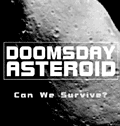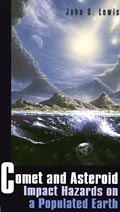
In the 1960s, a period that many called the Golden Age of Space, the public began to doubt the writings of lawyers who addressed space-related topics. Too many had jumped on board the ship, so to speak. Today, one area where the attention of lawyers is desperately needed relates to the mitigation of threats posed by asteroid or comet collisions with the Earth.
Aside from the efforts of nations to conduct sky searches and catalog potential threats, there exist few, if any, plans to evacuate nations, educate the public about the nature of a significant impact, or deal with the rationing of scarce resources, in the event that scientists or military personnel are unable to destroy or deflect an oncoming space body of significant mass.
In a recent study published by the Iowa Law Review, Policy Analyst Evan R. Seamone has addressed the duty to mitigate asteroid and comet impacts from the perspective of international law. The report argues that the nature of the dangers posed by asteroids and comets place the threat in the category of certain types of disasters for which the international community is unprepared. Similar threats include the mutation of the Acquired Immune Deficiency Syndrome into an airborne virus or the collapse of the Cumbre Vieja volcano in the Canary Islands, which would devastate multiple nations simultaneously.
Seamone argues that mitigating asteroid or comet threats necessarily involves preventive measures including the commitment of resources and personnel. He first explains the three major obstacles that must be overcome before mitigation efforts will succeed. First, the public must be educated to treat the threat seriously, an objective attainable by developing international protocols, especially involving warning mechanisms and the verification of actual threats. Second, the dangers posed by these unique threats must be situated in policies that extend beyond traditional disaster response measures at the international level, which often suffer from a lack of coordination. Third, duties to commit resources preventively must rest on principles other than the allocation of blame, which characterizes much of the corpus of law dealing with international responsibilities to mitigate transboundary harm.
Next, recognizing the danger posed to governments in the absence of serious preventive coordination, the report associates the duty to mitigate asteroid and comet impacts with General Principles of International Law, as recognized by the Statute of the International Court of Justice. The legal precedents supporting international cooperation hinge on the duty to self-preserve as articulated by philosophers such as Vattel and Hobbes and in numerous State Constitutions guaranteeing essential necessities such as air, food, and water, and the extension of that duty, which would require nations to cooperate in order to secure the survival of their own populaces, as indicated in legal opinions such as the Island of Palmas case.
After pointing out manifestations of nationsí adherence to the principle of cooperative preservation, through duties to warn other nations of impending danger, such as Article 28 of the International Law Commissionís Draft Articles on the Law of Non-Navigational Uses of International Water Courses, and duties to mitigate impending danger, such as Principle VII of Principles Relevant to the Use of Nuclear Power Sources in Outer Space, Seamone recommends international collaboration similar to the Scientific Committee on Antarctic Research (SCAR), which deals with issues facing the Antarctic region, endowed with certain unique powers to influence legislation and the allocation of resources.
 Comet and Asteroid Impact Hazards on a Populated Earth: Computer Modeling - By John S. Lewis: "Of all the natural hazards facing Earth, impacts are the most dangerous. Unlike native hazards of Earth's surface, impacts know no size limit. Their effects can be devastating over the entire surface area of our planet. They are the only credible natural threat to human civilization. But impacts, especially those of large bodies, are both predictable and avoidable. The NEO population constitutes both an unprecedented hazard and an unparalleled opportunity. It is sometimes said that there is a fine line that separates a threat from an opportunity. The near-Earth asteroids present us with just this dilemma. They present us with an intelligence test of the highest order, with the highest possible stakes for the future of the human race."
Comet and Asteroid Impact Hazards on a Populated Earth: Computer Modeling - By John S. Lewis: "Of all the natural hazards facing Earth, impacts are the most dangerous. Unlike native hazards of Earth's surface, impacts know no size limit. Their effects can be devastating over the entire surface area of our planet. They are the only credible natural threat to human civilization. But impacts, especially those of large bodies, are both predictable and avoidable. The NEO population constitutes both an unprecedented hazard and an unparalleled opportunity. It is sometimes said that there is a fine line that separates a threat from an opportunity. The near-Earth asteroids present us with just this dilemma. They present us with an intelligence test of the highest order, with the highest possible stakes for the future of the human race."
Comet and Asteroid Impact Hazards explores the anticipated consequences of comet and asteroid impact. It presents the first computer simulations of the hazards of comet and asteroid bombardment of a populated Earth. Previous estimates of fatality and damage rates on the 100 to 10,000 year time scale are shown to be too low because they neglect rare, highly lethal outriders of the populations of bombarding objects, those with exceptional strength, unusually low entry velocity, and near-horizontal entry angles. This is the first realistic assessment of both the mean casualty rate and the expected statistical fluctuations in that rate. A breakdown of fatality and damage rates by impactor energy and compositional class suggests lessons for both asteroid search strategies and interdiction techniques. This book is written so that anyone with college level experience in the physical sciences can understand it. It includes a disk that allows the reader to simulate impact catastrophes. It serves as a useful resource in various physical sciences courses such as astronomy, planetary science, and environmental science.
Rogue Asteroids and Doomsday Comets: The Search for the Million Megaton Menace That Threatens Life on Earth - The most authoritative, up-to-date and comprehensive book about the provocative predictions that an asteroid or comet might hit the Earth and destroy life as we know it. Presents the hard scientific facts behind the extensive sci-fi literature and press coverage. Provides a reliable assessment of the risks and explains exactly what the chances are that a disasterous impact will occur in our lifetime. Discusses the fascinating history of the destruction caused by asteroid and comet impacts on the Earth as well as the widely reported theory that a comet may have been responsible for life on our planet. Describes and assesses alternative plans for detecting and diverting an incoming asteroid or comet.